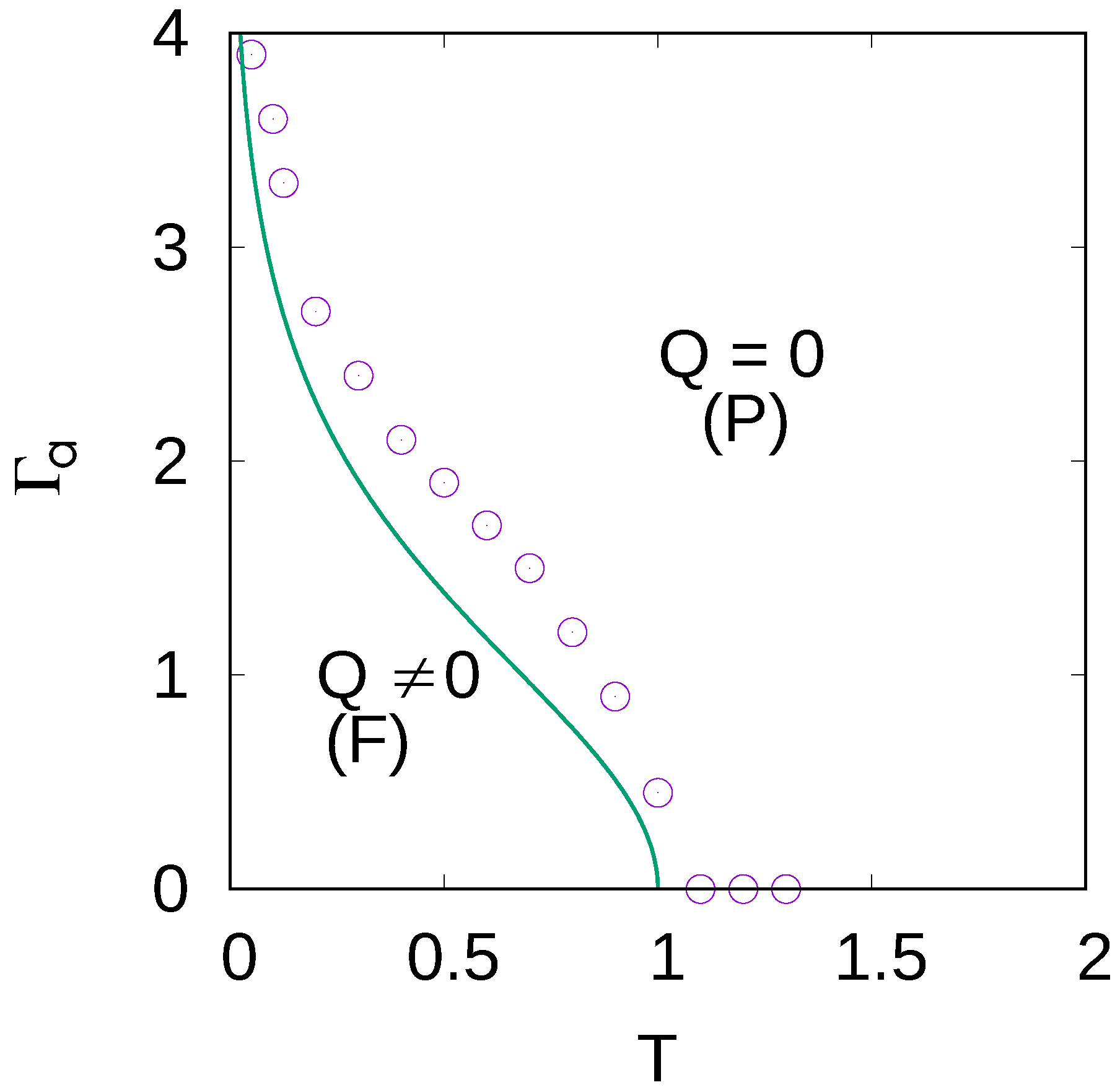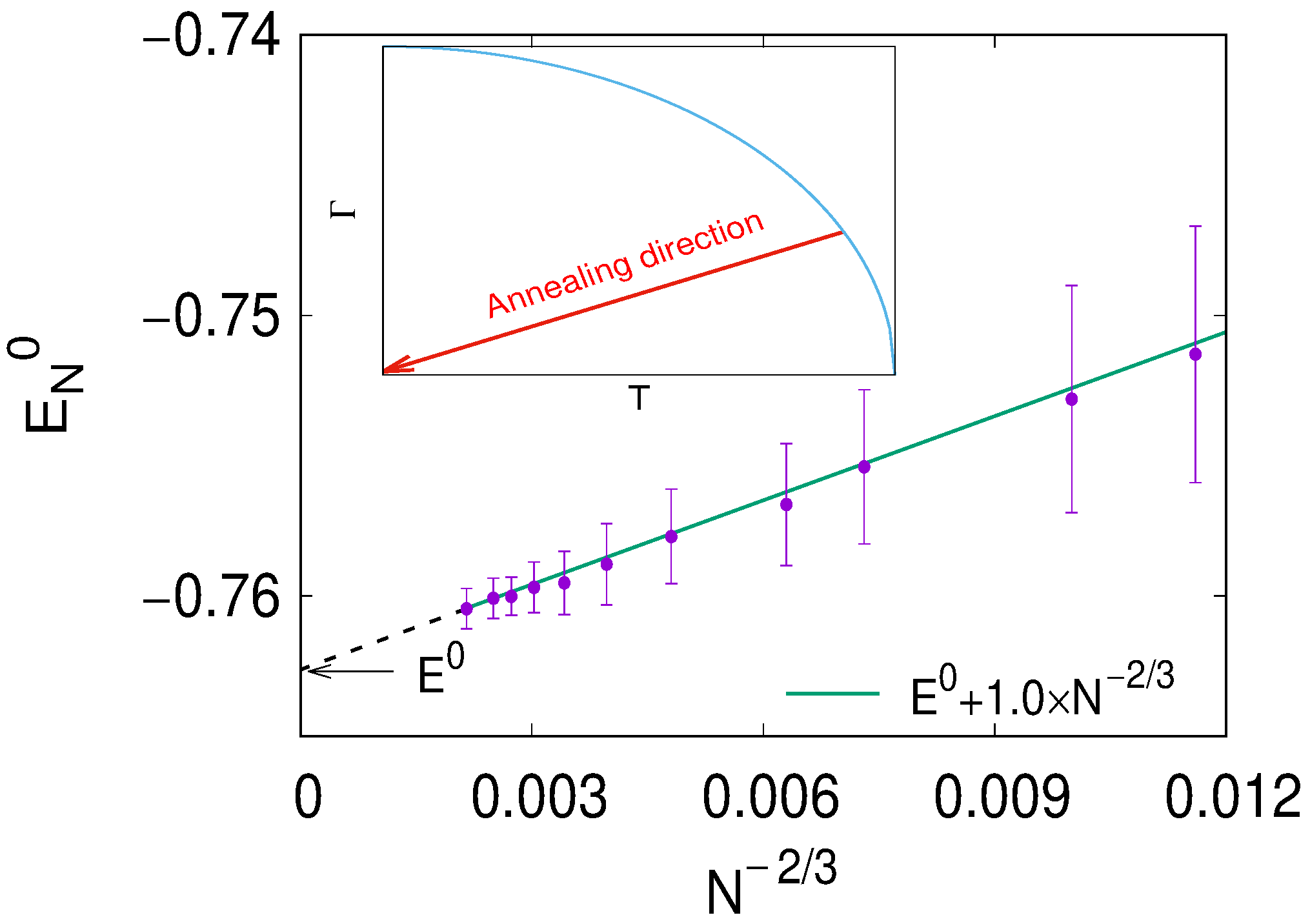de Gennes–Suzuki–Kubo Quantum Ising Mean-Field Dynamics: Applications to Quantum Hysteresis, Heat Engines, and Annealing
Abstract
1. Introduction
2. Anderson’s Pseudo-Spin Mapping of BCS Hamitonian & Mean Field Theory of BCS Superconductivity
2.1. Landau’s Phenomenological Theory of Superfluidity and Superconductivity
2.2. Mean Field Theory of BCS Superconductivity
- At :
- At :
3. de Gennes–Suzuki–Kubo Quantum Ising Mean-Field Dynamical Equation
3.1. Mean Field Dynamical Equation for a General Quantum Ising System
3.2. Quantum Ising Hysteresis and Dynamic Transition
3.3. Quantum Ising Heat Engine
- (i)
- Stroke-A → B: Field (transverse field , in quantum case) increases linearly with time from a low value, , to a high value, ) at a constant high temperature of the heat bath. Heat is being absorbed by the engine during this stroke. This is an isothermal ( constant) stroke. In this isothermal stroke, the system is allowed to absorb the heat from the reservoir. The internal energy of the system (working fluid of the quantum engine) increases in this stroke.
- (ii)
- Stroke-B → C: The system is being cooled (linearly from to ) with thermalization (with the cold bath or heat sink at temperature ) where the field remains fixed.
- (iii)
- Stroke-C → D: This is another isothermal (at ) stroke where the field decreases linearly from to ). The heat is being released hence the internal energy is found to decrease.
- (iv)
- Stroke-D → E: The temperature increases linearly (from to ) for fixed value of .
3.4. Quantum Annealing of the SK Model
4. Conclusions & Discussion
Author Contributions
Funding
Data Availability Statement
Acknowledgments
Conflicts of Interest
References
- Bardeen, J.; Cooper, L.N.; Schrieffer, J.R. Microscopic Theory of Superconductivity. Phys. Rev. 1957, 106, 162–164. [Google Scholar] [CrossRef]
- Anderson, P.W. Random-Phase Approximation in the Theory of Superconductivity. Phys. Rev. 1958, 112, 1900–1916. [Google Scholar] [CrossRef]
- de Gennes, P.G. Collective motions of hydrogen bonds. Solid State Commun. 1963, 1, 132–137. [Google Scholar] [CrossRef]
- Brout, R.; Muller, K.A.; Thomas, H. Tunnelling and collective excitations in a microscopic model of ferroelectricity. Solid State Commun. 1966, 4, 507–510. [Google Scholar] [CrossRef]
- Elliott, R.J.; Gehring, G.A.; Malozemoff, A.P.; Smith, S.R.P.; Staude, W.S.; Tyte, R.N. Theory of co-operative Jahn-Teller distortions in DyVO4 and TbVO4. J. Phys. C Solid State Phys. 1971, 4, L179. [Google Scholar] [CrossRef]
- Elliott, R.J.; Pfeuty, P.; Wood, C. Ising Model with a Transverse Field. Phys. Rev. Lett. 1970, 25, 443. [Google Scholar] [CrossRef]
- Pfeuty, P. The One-Dimensional Ising Model with a Transverse Field. Ann. Phys. 1970, 57, 79–90. [Google Scholar] [CrossRef]
- Stinchcombe, R.B. Ising model in a transverse field: I. Basic theory. J. Phys. C Solid State Phys. 1973, 6, 2459–2483. [Google Scholar] [CrossRef]
- Chakrabarti, B.K.; Dutta, A.; Sen, P. Quantum Ising Phases and Transitions in Transverse Ising Models; Springer: Berlin/Heidelberg, Germany, 1996. [Google Scholar]
- Barbar, M.N.; Duxbury, P.M. A quantum Hamiltonian approach to the two-dimensional axial next-nearest-neighbour Ising model. J. Phys. A Math. Gen. 1981, 14, L251. [Google Scholar] [CrossRef]
- Fisher, D.S. Random transverse field Ising spin chains. Phys. Rev. Lett. 1992, 69, 534. [Google Scholar] [CrossRef]
- Sen, P. Quantum phase transitions in the Ising model in a spatially modulated field. Phys. Rev. E 2000, 63, 016112. [Google Scholar] [CrossRef]
- Chakrabarti, B.K. Critical behavior of the Ising spin-glass models in a transverse field. Phys. Rev. B 1981, 24, 4062. [Google Scholar] [CrossRef]
- Suzuki, M.; Kubo, R. Dynamics of the Ising model near critical point—I. J. Phys. Soc. Jpn. 1968, 24, 51–60. [Google Scholar] [CrossRef]
- Acharyya, M.; Chakrabarti, B.K. Magnetic hysteresis loops as Lissajous plots of relaxationally delayed response to periodic field variation. Physical A 1994, 202, 467–481. [Google Scholar] [CrossRef]
- Acharyya, M.; Chakrabarti, B.K.; Stinchcombe, R.B. Hysteresis in Ising model in transverse field. J. Phys. A Math. Gen. 1994, 27, 1533–1540. [Google Scholar] [CrossRef]
- Acharyya, M.; Chakrabarti, B. Quantum Ising heat engines: A mean field study. Eur. Phys. J. B 2024, 97, 45. [Google Scholar] [CrossRef]
- Ray, P.; Chakrabarti, B.K.; Chakrabarti, A. Sherrington-Kirkpatrick model in a transverse field: Absence of replica symmetry breaking due to quantum fluctuations. Phys. Rev. B 1989, 39, 11828–11833. [Google Scholar] [CrossRef]
- Das, A.; Chakrabarti, B.K. Quantum Annealing and Analog Quantum Computations. Rev. Mod. Phys. 2008, 80, 1061–1081. [Google Scholar] [CrossRef]
- Tanaka, S.; Tamura, R.; Chakrabarti, B.K. Quantum Spin Glasses, Annealing and Computation; Cambridge University Press: Cambridge, UK, 2017. [Google Scholar]
- Rajak, A.; Suzuki, S.; Dutta, A.; Chakrabarti, B.K. Quantum annealing: An overview. Philos. Trans. R. Soc. A 2023, 381, 20210417. [Google Scholar] [CrossRef] [PubMed]
- Chakrabarti, B.K.; Mukherjee, S. Quantum annealing and computation. In Encyclopedia of Condensed Matter Physics, 2nd ed.; Elsevier: Amsterdam, The Netherlands, 2024; Volume 4, pp. 536–542. [Google Scholar] [CrossRef]
- Sherrington, D.; Kirkpatrick, S. Solvable Model of a Spin-Glass. Phys. Rev. Lett. 1975, 350, 1792–1796. [Google Scholar] [CrossRef]
- Binder, K.; Young, A.P. Spin glasses: Experimental facts, theoretical concepts and open questions. Rev. Mod. Phys. 1986, 58, 801–976. [Google Scholar] [CrossRef]
- Oppermann, R.; Schmidt, M.J.; Sherrington, D. Double Criticality of the Sherrington-Kirkpatrick Model at T = 0. Phys. Rev. Lett. 2007, 98, 127201. [Google Scholar] [CrossRef]
- Das, S.; Biswas, S.; Chakrabarti, B.K. Quantum Annealing in SK Model Employing Suzuki-Kubo-deGennes Quantum Ising Mean Field Dynamics. Eur. Phys. J. B 2025, 98, 226. [Google Scholar] [CrossRef]
- Das, S.; Biswas, S.; Chakrabarti, B.K. Classical Annealing of Sherrington-Kirkpatrick Spin Glass Using Kubo-Suzuki Mean-field Ising Dynamics. Phys. Rev. E 2025, 112, 014104. [Google Scholar] [CrossRef] [PubMed]
- Landau, L.D. On the Theory of Superfluidity. Phys. Rev. 1949, 75, 884. [Google Scholar] [CrossRef]
- Landau, L.D.; Lifshitz, E.M. Course of Theoretical Physics. In Statistical Physics, 1st ed.; Pergamon Press: Oxford, UK, 1951; Volume 5. [Google Scholar]
- Kittle, C. Quantum Theory of Solids; John Wiley: New York, NY, USA, 1987. [Google Scholar]
- Alicki, R. The quantum open system as a model of the heat engine. J. Phys. A Math. Gen. 1979, 12, L103. [Google Scholar] [CrossRef]
- Feldmann, T.; Kosloff, R. Quantum four-stroke heat engine: Thermodynamic observables in a model with intrinsic friction. Phys. Rev. E 2003, 68, 016101. [Google Scholar] [CrossRef] [PubMed]
- Mukherjee, V.; Divakaran, U. Many-body quantum thermal machines. J. Phys. Condens. Matter 2021, 33, 454001. [Google Scholar] [CrossRef]
- Bhattacharjee, S.; Dutta, A. Quantum thermal machines and batterie. Eur. Phys. J. B 2021, 94, 239. [Google Scholar] [CrossRef]
- Piccitto, G.; Campisi, M.; Rossini, D. The Ising critical quantum Otto engine. New J. Phys. 2023, 24, 103023. [Google Scholar] [CrossRef]
- Ishii, H.; Yamamoto, T. Effect of a transverse field on the spin glass freezing in the Sherrington-Kirkpatrick model. J. Phys. C Solid State Phys. 1985, 18, 6225. [Google Scholar] [CrossRef]
- Thouless, D.J.; Anderson, P.W.; Palmer, R.G. Solution of ‘Solvable model of a spin glass’. Philos. Mag. 1977, 35, 593. [Google Scholar] [CrossRef]
- Kadwaki, T.; Nishimori, H. Quantum annealing in the transverse Ising model. Phys. Rev. E 1998, 58, 5355. [Google Scholar] [CrossRef]
- Boettcher, S. Extremal optimization for Sherrington-Kirkpatrick spin glasses. Eur. Phys. J. B 2005, 46, 501. [Google Scholar] [CrossRef]
- Palassini, M. Ground-state energy fluctuations in the Sherrington–Kirkpatrick model. J. Stat. Mech. Theory Exp. 2008, 2008, P10005. [Google Scholar] [CrossRef]
- Suzuki, S.; Inoue, J.-I.; Chakrabarti, B.K. Quantum Ising Phases and Transitions in Transverse Ising Models; Springer: Berlin/Heidelberg, Germany, 2013. [Google Scholar]
- Blinc, R. On the isotopic effects in the ferroelectric behaviour of crystals with short hydrogen bonds. J. Phys. Chem. Solids 1960, 13, 204–211. [Google Scholar] [CrossRef]
- Blinc, R.; Žekš, B. Proton order-disorder in KH2PO4-type ferroelectrics: Slater theory and ising model in a transverse tunneling field. Ferroelectrics 1987, 72, 193–227. [Google Scholar] [CrossRef]
- Yokota, T. Phase diagram for the infinite-range transverse Ising spin-glass model. Phys. Rev. B 1989, 40, 9321–9323. [Google Scholar] [CrossRef]
- Parisi, G. Infinite Number of Order Parameters for Spin-Glasses. Phys. Rev. Lett. 1979, 43, 1754. [Google Scholar] [CrossRef]
- Parisi, G. A sequence of approximated solutions to the S-K model for spin glasses. J. Phys. A 1980, 13, 1101. [Google Scholar] [CrossRef]
- Elliott, R.J.; Wood, C. The Ising model with a transverse field. I. High temperature expansion. J. Phys. C Solid State Phys. 1971, 4, 2359. [Google Scholar] [CrossRef]
- Pfeuty, P.; Elliott, R.J. The Ising model with a transverse field. II. Ground state properties. J. Phys. C Solid State Phys. 1971, 4, 2370. [Google Scholar] [CrossRef]
- Stinchcombe, R.B. Ising model in a transverse field. II. Spectral functions and damping. J. Phys. C Solid State Phys. 1973, 6, 2484–2506. [Google Scholar] [CrossRef]
- Banerjee, V.; Dattagupta, S.; Sen, P. Hysteresis in a quantum spin model. Phys. Rev. E 1995, 52, 1436. [Google Scholar] [CrossRef]
- Sen, P. Application of the interface approach in quantum Ising models. Phys. Rev. B 1997, 55, 11367. [Google Scholar] [CrossRef]
- Jullien, R.; Pfeuty, P.; Fields, J.N.; Doniach, S. Zero-temperature renormalization method for quantum systems. I. Ising model in a transverse field in one dimension. Phys. Rev. B 1978, 18, 3568. [Google Scholar] [CrossRef]
- Sachdev, S. Quantum Phase Transitions, 2nd ed.; Cambridge University Press: Cambridge, UK, 2011. [Google Scholar]
- Chakrabarti, B.K.; Acharya, M. Dynamic transitions and hysteresis. Rev. Mod. Phys. 1999, 71, 847–849. [Google Scholar] [CrossRef]
- Stojnic, M. Binary perceptron computational gap—A parametric fl RDT view. arXiv 2025, arXiv:2511.01037. [Google Scholar] [CrossRef]
- King, A.D.; Nocera, A.; Rams, M.M.; Dziarmaga, J.; Wiersema, R.; Bernoudy, W.; Raymond, J.; Kaushal, N.; Heinsdorf, N.; Harris, R.; et al. Beyond-classical computation in quantum simulation. Science 2025, 388, 199–204. [Google Scholar] [CrossRef]
- Peronaci, F.; Schiró, M.; Capone, M. Transient Dynamics of d-Wave Superconductors after a Sudden Excitation. Phys. Rev. Lett. 2015, 115, 257001. [Google Scholar] [CrossRef] [PubMed]
- Nava, A.; Perroni, C.A.; Egger, R.; Lepori, L.; Giuliano, D. Lindblad master equation approach to the dissipative quench dynamics of planar superconductors. Phys. Rev. B 2023, 108, 245129. [Google Scholar] [CrossRef]
- Yuzbashyan, E.A.; Dzero, M.; Gurarie, V.; Foster, M.S. Quantum quench phase diagrams of an s-wave BCS-BEC condensate. Phys. Rev. A 2015, 91, 033628. [Google Scholar] [CrossRef]









Disclaimer/Publisher’s Note: The statements, opinions and data contained in all publications are solely those of the individual author(s) and contributor(s) and not of MDPI and/or the editor(s). MDPI and/or the editor(s) disclaim responsibility for any injury to people or property resulting from any ideas, methods, instructions or products referred to in the content. |
© 2025 by the authors. Licensee MDPI, Basel, Switzerland. This article is an open access article distributed under the terms and conditions of the Creative Commons Attribution (CC BY) license (https://creativecommons.org/licenses/by/4.0/).
Share and Cite
Das, S.; Biswas, S.; Acharyya, M.; Chakrabarti, B.K. de Gennes–Suzuki–Kubo Quantum Ising Mean-Field Dynamics: Applications to Quantum Hysteresis, Heat Engines, and Annealing. Condens. Matter 2025, 10, 58. https://doi.org/10.3390/condmat10040058
Das S, Biswas S, Acharyya M, Chakrabarti BK. de Gennes–Suzuki–Kubo Quantum Ising Mean-Field Dynamics: Applications to Quantum Hysteresis, Heat Engines, and Annealing. Condensed Matter. 2025; 10(4):58. https://doi.org/10.3390/condmat10040058
Chicago/Turabian StyleDas, Soumyaditya, Soumyajyoti Biswas, Muktish Acharyya, and Bikas K. Chakrabarti. 2025. "de Gennes–Suzuki–Kubo Quantum Ising Mean-Field Dynamics: Applications to Quantum Hysteresis, Heat Engines, and Annealing" Condensed Matter 10, no. 4: 58. https://doi.org/10.3390/condmat10040058
APA StyleDas, S., Biswas, S., Acharyya, M., & Chakrabarti, B. K. (2025). de Gennes–Suzuki–Kubo Quantum Ising Mean-Field Dynamics: Applications to Quantum Hysteresis, Heat Engines, and Annealing. Condensed Matter, 10(4), 58. https://doi.org/10.3390/condmat10040058






